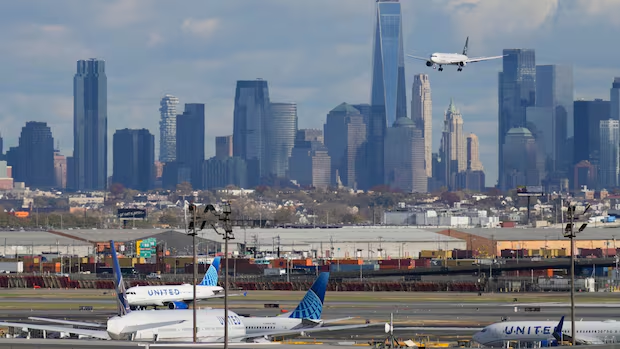FAA is reducing flights at 40 U.S. airports. Here’s how Canadian travel will be affected

Listen to this article
Estimated 6 minutes
The audio version of this article is generated by text-to-speech, a technology based on artificial intelligence.
Canadian travellers bound for the United States in the next few days may want to check their flights.
While international flights are exempt from the Federal Aviation Administration’s (FAA) plan to reduce air traffic by 10 per cent across 40 of the busiest U.S. airports, Canadians could still see some cancellations and delays due to the cascading effects of the federal government shutdown south of the border. Here’s a closer look at what to know:
What’s happening at U.S. airports?
The FAA said Wednesday it would cut flights by 10 per cent across 40 airports — including major hubs such as New York City and Chicago — starting Friday due to the U.S. government shutdown.
The reductions will start at four per cent on Friday and ramp up to 10 per cent by Nov. 14, in effect between 6 a.m. to 10 p.m. local time for all commercial airlines.
The agency said the reduction is necessary to maintain travel safety as unpaid air traffic controllers exhibit signs of strain during the shutdown — now the longest ever at 37 days and counting.
CBC News has reached out to both the FAA and the U.S. Department of Transportation (DOT) for more information but has not yet received a response. In an automated email, the FAA said that “due to a lapse in funding, the FAA is not responding to routine media inquiries.”
Which U.S. airports are affected?
Airports in New York, Los Angeles and Chicago, along with hubs across the U.S., are among the 40 that will see flights cut starting Friday.
The airports impacted cover the busiest across the U.S. — including Atlanta, Denver, Dallas, Orlando, Miami and San Francisco. In some of the biggest cities — such as New York, Houston and Chicago — multiple airports will be affected.
A list is included at the bottom of this story.
WATCH | Some of the busiest U.S. airports will see fewer flights:
U.S. government shutdown to force domestic flight reductions
Travellers going through some of the busiest airports in the U.S. will see fewer domestic flights, with the Federal Aviation Administration reducing air traffic volume beginning Friday. Air traffic controllers in the U.S. have been working unpaid since Oct. 1 as the government shutdown drags into a second month.
How will this affect flights?
Airlines are currently figuring this out. The cuts could include up to 1,800 flights and about 268,000 seats combined, according to one estimate reported by The Associated Press. United Airlines and Delta Air Lines both said they would offer refunds to travellers who opt not to fly, even if they have tickets that aren’t normally refundable. The FAA is also imposing drastic restrictions on space launches and general aviation.
How does this affect Canadians?
Canadian airlines operate thousands of cross-border flights weekly, with connections to hundreds of different routes via partner carriers.
Air Canada, for example, told CBC News that it’s maintaining its “normal schedule” but added that customers connecting to U.S. domestic flights with its partner, United Airlines, may be affected and that it is already experiencing delays.
“All carriers operating in the U.S. have been affected. For our part, we have experienced a limited number of manageable delays to this point but … this is an ongoing situation,” the airline said in a statement.
Air Canada said it was allowing customers connecting with United to change or defer their travel with no change fee.
Porter Airlines said that flights in and out of the U.S. have been disrupted due to FAA staffing shortages, causing delays in some of its markets.
“Our team is managing the disruptions,” Porter said in an email statement. “For those who have flexibility, complimentary moves to some U.S. destinations are available through Monday, when space permits.”
Passengers look at an airplane at San Francisco International Airport on Thursday. (Carlos Barria/Reuters)
WestJet said it was monitoring the situation but that its operations haven’t been affected.
Transport Canada said it’s monitoring the situation, adding that travellers leaving Canadian airports should check the status of their flights in advance.
It’s not just U.S. flights: aviation expert
John Gradek, a lecturer in aviation management at McGill University in Montreal, says because the North American air travel system is integrated, U.S. airport delays affecting planes destined for Canada could cause cascading delays throughout the Canadian system.
But Gradek says that’s not the only problem. Another one is airspace.
If someone is flying from southern Ontario to Western Canada, he said, “a significant portion of that flight is overflying U.S. airspace.” Flights to Mexico also go over the United States, he said.
If the specialized air traffic controllers who handle that part of American airspace stop showing up to work, it could hinder Canadians’ travel plans, he said.
Finally, here’s a full list of affected U.S. airports
- John F. Kennedy International in New York.
- LaGuardia Airport in New York.
- Newark Liberty International in New Jersey.
- Teterboro in New Jersey.
- Boston Logan International in Massachusetts.
- Philadelphia International in Pennsylvania.
- Ronald Reagan Washington National in Virginia.
- Washington Dulles International in Virginia.
- Baltimore/Washington International in Maryland.
- Cincinnati/Northern Kentucky International in Ohio.
- Hartsfield-Jackson Atlanta International in Georgia.
- Dallas Love Field in Texas.
- Dallas Fort Worth International in Texas.
- George Bush Intercontinental in Texas.
- Houston Hobby in Texas.
- Charlotte Douglas International in North Carolina.
- Miami International in Florida.
- Fort Lauderdale-Hollywood International in Florida.
- Tampa International in Florida.
- Orlando International in Florida.
- Louisville International in Kentucky.
- Memphis International in Tennessee.
- Chicago O’Hare International in Illinois.
- Chicago Midway International in Illinois.
- Minneapolis-Saint Paul International in Minnesota.
- Detroit Metropolitan Wayne County in Michigan.
- Indianapolis International in Indiana.
- Los Angeles International in California.
- Oakland International in California.
- Ontario International in California.
- San Francisco International in California.
- San Diego International in California.
- Seattle-Tacoma International in Washington.
- Salt Lake City International in Utah.
- Anchorage International in Alaska.
- Denver International in Colorado.
- Phoenix Sky Harbor International in Arizona.
- Honolulu International in Hawaii.
- Harry Reid International Airport in Las Vegas.
- Portland International in Oregon.





